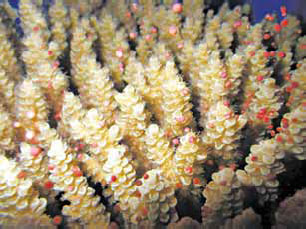Frozen sperm may be a lifeline for coral
Updated: 2012-08-05 08:02
By Michelle Nijhuis(The New York Times)
|
|||||||
|
A scientist collects coral sperm hoping to restore dying reefs. Acropora tenuis coral releases sperm. Andrew Heyward / Australian Institute of Marine Science |
COCONUT ISLAND, Hawaii - Just before sunset, on the campus of the Hawaii Institute of Marine Biology, Mary Hagedorn waited for her mushroom corals to spawn.
As corals go, Fungia is fairly reliable, usually releasing its sperm and eggs two days after the full moon. Today was Day 3. Sometimes it does not cooperate, she fretted.
The recalcitrant corals sat outdoors in water-filled glass dishes. Each was about the size and shape of a portobello mushroom cap, with a sunburst of brown ribs radiating from a pink, tightly sealed mouth.
As Dr. Hagedorn and her assistant watched, one coral tightened its mouth and seemed to exhale, propelling a cloud of sperm into its bath with surprising vigor. The water bubbled like hot oatmeal.
A reproductive physiologist with the Smithsonian Institution, Dr. Hagedorn, 57, is building a sperm bank for the world's corals. She hopes her collection - gathered from corals in Hawaii, the Caribbean and Australia - will be used to restore and even rebuild damaged reefs.
She estimates that she has frozen one trillion coral sperm, enough to fertilize one billion eggs. There are also three billion frozen embryonic cells; some have characteristics of stem cells, meaning they may be able to grow into adult corals.
Fragments of coral can grow into clones of their parents. But Dr. Hagedorn said that only sexual reproduction maintains genetic diversity within populations, and with it a species' capacity to survive and adapt. For corals, the number of likely partners is shrinking: As climate change warms the oceans, corals are becoming more vulnerable to disease - and to bleaching, a condition in which stressed coral expel the colorful algae critical to their food supply.
In recent years, bleaching events have grown from local curiosities to global phenomena, and in some cases the corals cannot recover. Meanwhile, rising levels of carbon dioxide are acidifying the oceans, inhibiting the growth of coral skeletons and slowly weakening reefs worldwide.
In the Caribbean, high water temperatures, disease outbreaks, overfishing and other afflictions have killed 80 percent of the region's coral. Similar problems are killing coral in the Pacific; in the central and western parts of that ocean the extent of living coral is thought to have shrunk by half between the early 1980s and 2003.
If this decline continues, almost all of the world's reefs will be on their way to oblivion by 2050. An estimated one-fourth of all known marine species have some association with coral reefs; some may be able to survive on seaweed, but not all.
For marine scientists whose careers depend on coral reefs, Dr. Hagedorn's collection can be reassuring. "Mary is my insurance policy," said Greta Aeby, a biologist who works in a dockside laboratory on Coconut Island and studies coral disease throughout the Pacific.
"We're working as quickly as we can," she added, "but it's not enough. I keep telling my students, 'Study faster!' "
For decades, conservationists have worked to protect reefs with marine reserves, fishing regulations and other measures. But just 27 percent of the world's reefs lie within reserves. As the pressures of climate change increase, biologists say the future of coral reefs relies on refuges, or refugia - places where local threats are minimal, or where the corals are biologically more adaptable to change.
Though Dr. Hagedorn supports these traditional conservation strategies, she is preparing for their failure.
But she and her colleagues have to struggle to raise money for her efforts, which are often seen as a distraction from habitat protection. "In an ideal world, we would do both," said Stephen Palumbi, director of the Stanford University Hopkins Marine Station in Pacific Grove, California. "Of course, in an ideal world, there would be no funding constraints." Still, both strategies may ultimately be necessary. "Protecting fish communities, making sure water quality is good, all of those efforts can buy decades of time," said Nancy Knowlton, a prominent coral-reef biologist, also at the Smithsonian Institution. "But if we continue on this greenhouse-gas emissions trajectory, the only place we're going to be able to find many corals will be in Mary's freezers."
The New York Times
(China Daily 08/05/2012 page11)
